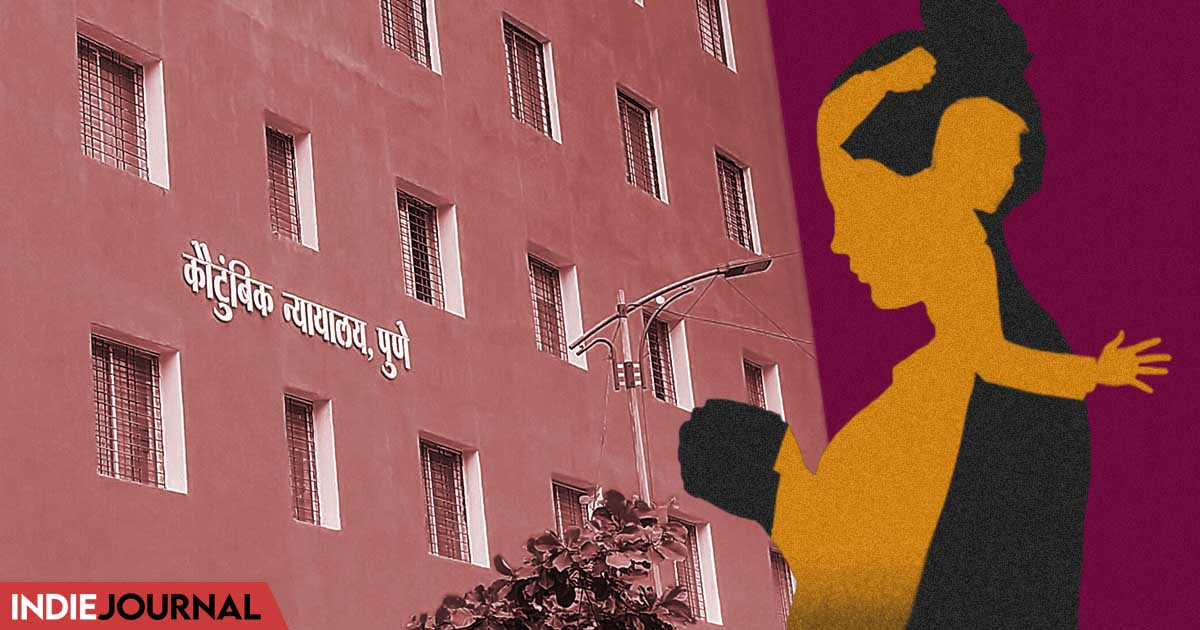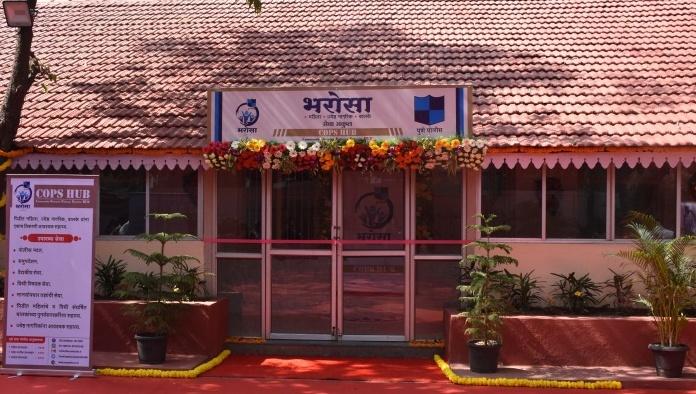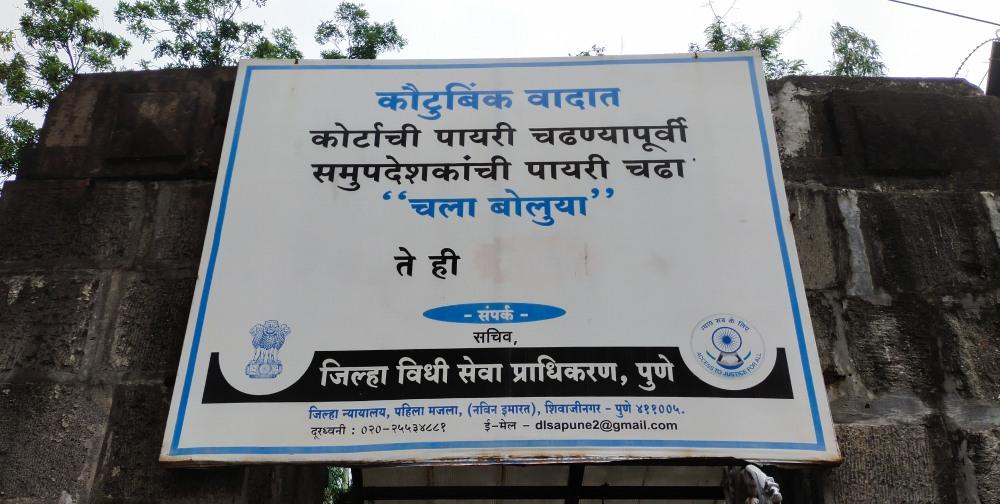India
Domestic violence law perfect on paper, falters in action
The National Family Health Survey states that 86 percent of the women victims of domestic violence never seek help.

This report was produced through the grants provided under the Laadli Media Fellowship 2022.
Snehal Mutha | “I was in death bed waiting for surgery. I sent my children to their father, thinking at least he will take care of them. I was disappointed he did not. With an income of only six thousand per month, how would someone run a family of four? I had no choice left than going to court,” says Maya, 32, who lives in Pune.
Maya's in-laws physically abused her and the children. The spouse abandoned Maya after she was diagnosed with tuberculosis (TB). She received the infection most probably from her father-in-law, who was already suffering from TB. During that time, she was pregnant with her third child. Post pregnancy Maya was paralysed below the waist due to the severity of the disease. Maya’s extended family never allowed her children to step into the house. Police officers asked her and the maternal family to keep the children, citing that their father won’t be able to take care of them 'like a mother does'.
At last, Maya filed a case under the Protection of Women from Domestic Violence Act (PWDV), 2005, over a year ago. Since then, she is waiting for justice to be served.
Innumerable more Mayas across the country are waiting to get relief under the PWDV act. BMC Women’s Health conducted a study on domestic violence faced by Indian women from 2001 to 2018 and found a total of 15,48,548 cases reported of cruelty by husbands or their relatives in India, with 5,54,481 (35.8 percent) taking place between 2014 and 2018. The inadequate response is made stark by the fact that only 6.8 percent of the cases filed completed trials in 2018.
The Parliament passed the PWDV act as an impediment to domestic violence and to combat all the loopholes present in Section 498(A) Indian Penal Code (IPC) provision. PWDV provides various substantive reliefs that include Protection Orders, Residence Orders, Monetary Reliefs, Custody Orders and Compensation Orders. Although, the act is picture-perfect on paper has discrepancies in implementation. National Family Health Survey states that 86 percent of the women victims of domestic violence never seek help, which means only 14 percent do. Among them, only 7 percent reach out to the relevant authorities under the DV Act.
Discrepancies in practicing law
One of the primary reasons behind this is inevitable matters of court. Often courts are overburdened with cases. From the judge to a service provider, everyone performs multiple roles. On respective hearings, sometimes lawyers and judges are absent or the respondent is unavailable. Hence, hearings keep on getting postponed. Advocate Archana Ghodekar says, “The Courts have their limitations, improvements in the system are a must. Besides, the law on paper is great but lacks implementation. Respondents are smart enough to get rid of the implications. In such a scenario, the stipulated 60 days period is impossible for an order."
86 percent of the women victims of domestic violence never seek help, which means only 14 percent do.
Pinky filed a PWDV case to receive healthcare expenses for her daughter suffering from diabetes. "A notice was issued for the same, but my husband did not acknowledge it and the process was delayed to another date," she says, adding, “It took me five hearings to avail documents from my husband, the case would not move ahead without the documents."
If a woman reports violence in any form - physical, financial, mental, verbal or sexual - the PWDV can be filed. Technically, the procedure starts when the Protection officer (PO) fills in Domestic Incident Report (DIR) and later courts issue orders that are sent to the accused.
Preeti Karmakar, founder of Nari Samata Manch, Pune points out, “Issuing a primary notice takes six months, cases will delay. If you check records, cases are delayed for more than two years. The process is so lengthy and tiring. These things are not seen at a minute level. A woman who has limited access to resources has to first file DIR, give it in the court, send it to police officers and so on. It is the responsibility of service providers, but the woman does it all. For that matter, DV cases are heard in front of first-class judicial magistrates, it should be in family court. Given the quasi nature of law, gender sensitivity is questionable here.”
Interim orders and maintenance payment lapses
In many of these cases, several notices were issued, but the respondents did not appear, then an ex parte order is passed considering the woman’s position. If a woman is demanding maintenance, then a nominal amount is ordered. Later a warrant is issued, if the order lapsed.
Such an Ex parte order was passed in Vaishnavi’s case as the respondent never showed up in court. Vaishnavi filed a case in 2018 for the maintenance of her daughter, who was born underweight. She was issued a maintenance order of Rs 10,000. Komal filed a case against her husband, after which maintenance of Rs 20,000 per month was allotted. So far, the respondent was supposed to pay Rs 14 lakhs, however, by far only Rs 3,000 were recovered out of the total money. In between various notices and warrants were issued.
In the case of Razia, the order of giving maintenance of Rs 5,000 was passed. She was suffering from AIDS. The payment stopped after a few months. Razia felt no interest in further pursuing the case. In all the cases, maintenance payment has lapsed and Ex parte orders made no huge difference. Meanwhile, if a woman starts earning and the husband proves her incomes are enough for survival, a maintenance order is a difficult avail, or only 20 percent is ordered of what is demanded.

The question is what is to be done in such cases, especially since the orders passed are of meager amounts. Filing a recovery case further incurs expenses, which are often more than the amount allotted. Database falls short of compiling such cases and analysing the numbers. Cases are closed, but how well the verdicts were implemented is left open-ended.
Lawyer Supriya Kothari says, “When delays are made, no immediate action is taken. For years together dates are given, but the respondent is absent and the case gets stagnant. Lapses in interim forces issue of the warrant. Many times whereabouts of the respondents are unknown. Finding and putting him behind bars is a long process, women get tired of court. People are smart enough to resign from their jobs, change residences and more. Such a pattern is visible in people with IT backgrounds or families living in slums. Few respondents who are not willing to pay also do not mind serving jail time (three to six months). In such cases, what are the remedies? At the end of the day, aggrieved women are left aggrieved only.”
Faded criminality of law
Police, court at any point of time can insert section 498 of the IPC if an aggrieved woman has suffered assaults and life-threatening events. However, rarely any action is taken. PWDV is only meant for providing relief. Most women file cases to avail economic support for their children. However, there are few out there who want their husbands to pay for their misdeeds. Despite the law being of criminal nature, it loses its severity and fails to address such cases.
Also, ongoing cases of 498 do not draw a rosy picture. According to the analytical study by Factly, a data journalism website, pending cases under Section 498A have doubled in the 13 years to 2018, with an increase of 10 percent every year. The National Crime Records Bureau (NCRB) 2018 report shows that more than one lakh cases under Sec 498A were reported in India in 2018. If 498A is applied to the PWDA cases, there is also a probability of increasing the number of cases of crime against women, as was reported in 2018.
Problem with the entire system
Before a case reaches court, the system provides facilities where women can get their issues addressed. Bharosa Cell (Family Counselling centre), One stop Centres and Service Providers under PWDV law are somewhat interlinked. Counselling is provided at all levels. The motto is to save family breakdown and control divorces. For the current year, up till now, the cell has received 1,879 cases, out of which 437 are settled, counseling is going on for 979, 135 are in courts and 139 are criminal cases. The data shows that 1,879 cases could have been court cases.
Although it is accessible to the masses, it lacks effectiveness. In a few cases, women turn to Mahila NGOs after visiting Bharosa's cell. Poonam, a counsellor says, “Counselling that we provide is from a gender equality perspective. So, gender sensitisation among public departments is questionable. When the case comes up, the work starts right from helping the woman identify the violence that happened to her to building her confidence. The process is similar for respondents."

One Stop Centre is an excellent idea, it's a one stop for all the facilities that a victim can avail. Only the limitation is that the capacity is five and each woman can stay only five days. Later, she has the option to live at a shelter home as prescribed by the centre.
Private lawyers are preferable
Vidya says, “If an advocate is paid, he will do your work fast. I was not sure having a free advocate would have helped me fasten the process. Earlier, I was unaware that government provides legal aid."
Vidya, 38, married for 16 years belongs to Medshingi, Sangola, Solapur. Vidya suffered financial and verbal violence at the hands of her in-laws. Vidya’s spouse assassinated her character at her workplace. She is waiting to get divorced, only after receiving certain property under the name of her children and a maintenance order for the family. Currently, Vidya earns approximately Rs 8,000. For Vidya, hiring a private lawyer is expensive, she promised to pay fees of Rs 17,000.
Protection officer’s dilemma
Protection officers are a crucial stakeholder in PWDV law and the most important network point for women. However, there have been several complaints about protection officers not working effectively. Recently, Ngo 'We the Women of India' filed a PIL in Supreme Court seeking to plug massive gaps in infrastructure under PWDV across the country. Pune PO office is in Somwar Peth, where there is limited space for sitting. If a woman with trauma seeks help, the environment won’t allow expressing her suffering.
Speaking to domestic violence survivors, none of them had an idea about their protection officers. The majority of them had private lawyers. Hardly, anyone had an idea about legal aid.
Advocate Sneha says, “PO takes 5-6 months to send notices, how to proceed faster. In courts, we are confused about whether PO did their job. Filing complaint against them is another ruckus. They being the first stakeholder in entire PWDA, delay on their part, resultinng in postponement of orders.”
Anjana Mojar, Pune District Head Protection Officer says, “We too have ample work on our plate. If the entire system works together, only then the law can be successfully implemented. PO alone cannot do anything. Few departments are also unaware of DV’s process and how the system works in these matters. We have certain limitations, be it infrastructure or awareness.”Bhagyashree Ghadge, Haveli taluka PO says, “Cases are increasing. Daily five to six cases are reported. We do what is possible. Even we face problems while implementing an order. Several times court order lacks clarity. People don’t listen and we don’t have clear order to counter them."
Lack of awareness of PWDV
PWDV is unfamiliar to many. When violence becomes intolerable, her last resort is to file complaints with the police or at the most, reaching out to NGOs. One of the roles of a protection officer is to create awareness at gram panchayat. However, ground realities seem different.
Akash Daunde says, “Socio-economic security of that woman is ruined. The attitude of the police toward her is not at all empathetic. Court and everything come last only if it is about her children. Awareness camps about PWDV are far away, the women are hardly aware of the violence happening to them. So far, in our village, I never come across any of such camps." Akash Daunde is a Deputy Sarpanch of Sontale village, Nalwade, Pathardi.

Rupali, an Asha worker from Apshinge, Rehmatpur, Satara has a similar observation. She never came across any PWDV awareness events. She has no idea about protection officers.
Vaishali from Nirman Ngo says, “Even if women access law through private lawyers, it is difficult for her to prove domestic violence. Women face inconvenience while filing evidence. Due to financial dependency, they are unaware of the assets in the name of the accused or his further marital status. She doesn’t know even medical bills are proof of her bruises. If women are from a marginalised community, they refrain from accessing court, citing the fear that came from the criminal tribe act. So they try to go and get it resolved in the community only. Only the removal of gaps in knowledge among women can help to take support of the court.
It has been over 15 years since the PWDV law was brought into existence. Yet, there are hardly any studies on the success rate of the law, loopholes and necessary amendments to be made. The majority are underreported and the reported ones take a longer time to deliver relief or punish the offender. There are micro-level problems that need urgent attention to achieve greatness while practicing it. Case studies of PWDV put a light on how violence is used as a political tool to have control of other person’s life. The reasons for violence can be a study of changing trends of violence. As women are being financially independent or claiming public spaces be it farming, labour work or office, it is also attracting more violence.
*Names of all the survivors of the domestic violence interviewed for the story have been changed for maintaining anonymity.






